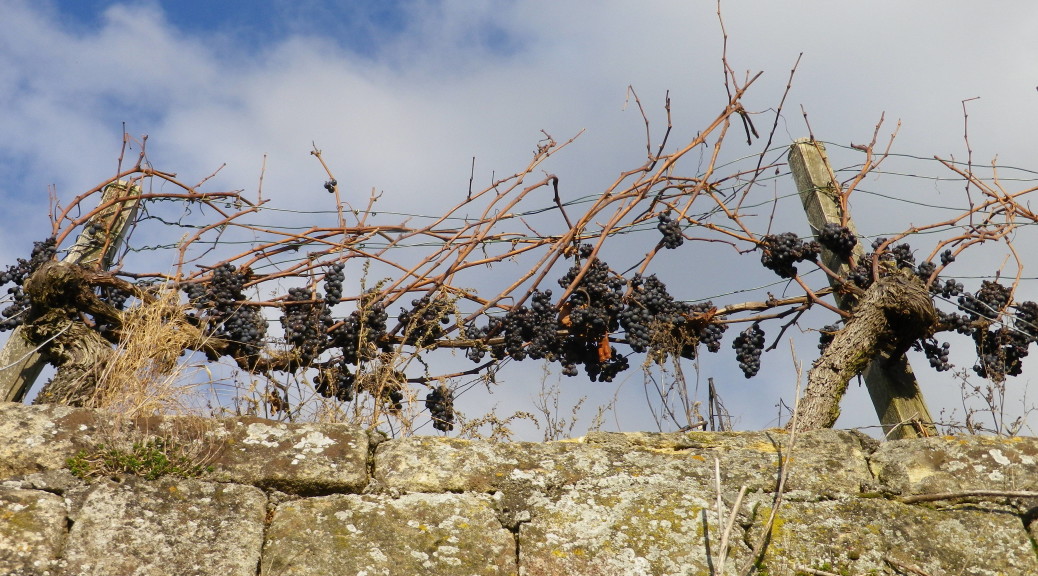What I Learned
Wuerttemberg is a large and diverse wine region. Throughout the region red varietals tend to predominate, especially the Trollinger variety. The part of the trail through greater Stuttgart essentially covered two of Wuerttemberg’s six wine districts. This post includes the Stuttgart and Remstal districts. These are right along the Wuerttembergische Weinwanderweg trail, slightly north and east of Stuttgart, and as far south as Esslingen.
The Remstal wine district is along the Rems River, located a few kilometers northeast of Stuttgart’s city center. Winnenden is the first town along the trail to fall within the Remstal-Stuttgart wine district, although the river valley itself only comes into view above Kleinheppach. With slightly over 600 hectares, the grapes here grow in soil that is 90% keuper (consisting of marl and limestone). Trollinger is the predominant varietal followed by Riesling, Kerner (a Trollinger and Riesling cross), Schwarzriesling, Lemberger, Mueller-Thurgau, Spaetburgunder, Dornfelder, Portugieser, and Silvaner, in that order. The information about this area was provided by the Remstalkellerei, a wine cooperative (and wine shop) that makes and markets wines from this district in large amounts. (This is a popular winery whose products grace the shelves of many German supermarkets, especially in the Stuttgart area.)
A few kilometers south of the Remstal, is Stuttgart, the only city in Germany to have grapes growing within its limits. The city districts of Rotenberg, Uhlbach, Obertuerkheim and Untertuerkheim, once small towns in their own right, are within Stuttgart. These areas, and the town of Esslingen (home to the Kessler sparkling wine producers) are along the Neckar. According to the one of the area’s wineries, the Collegium Wirtemberg, a little more than 70 per cent of the grapes grown in this district are red varietals. Trollinger being the most predominant, although other red varietals include Spaetburgunder and Lemberger. Riesling is also here, as well as Weissburgunder (Pinot Blanc), Grauburgunder (Pinot Gris) and Silvaner.
These areas present a wide variety of unusual wines with lots of variations from the many wineries! Easily accessible from downtown Stuttgart by metro rail, this area has an unusual concentration of vintners, wineries, and wine taverns and shops for visitors to enjoy. Below are some of the wines produced within both these districts of the southern part of the Wuerttemberg region, which I tried while there.
What I Tasted
2014 Riesling, Alte Reben, Qualitaetswein, Collegium Wirtemberg (Stuttgart): A dry white wine with light gold color; fruity and mineral nose, with citrus and mineral flavors; medium acidity.
2014 Grauer Burgunder, Qualitaetswein, Weinmanufaktur Untertuerkheim; A dry white wine with light gold color; nose of light green apple scents, some pear flavor; medium plus acidity.
2014 Trollinger, Rotenberger Schlossberg, Qualitaetswein, Collegium Wirtemberg (Stuttgart): A dry red wine with very light red color; a sweet nose of cherry; cherry, apple and smoky flavors, with a hint of tartness on the finish; medium tannins.
2014, Riesling, Schiefer, Trocken, QbA, Fellbacher Weingaertner (Fellbach): A dry white wine with light gold color, sharp citrus nose, flavors of green apple and citrus; medium plus acidity.
2013 Riesling, Predikaet, Trocken, Weingut Warth (Untertuerkheim): A dry white wine with medium gold color; fruity nose of peach and melon, and a hint of honey, spice, and slight citrus flavors, making this tart, but not sour; mild acidity.
2013 Weissburgunder, Predikaet, Trocken, Weinmanufaktur Untertuerkheim: A dry Pinot Blanc with light gold color; fruity nose with flavor notes of melon and banana; a racy acidity
2013 Grauburgunder, Predikaet, Trocken, Weinmanufaktur Untertuerkheim: A dry Pinot Gris with medium gold color; sweet nose of flowers and pear; flavor notes of pear and banana; medium acidity.
2012 Lemberger, Cannstadter Berg, Auslese, Trocken, Weingut Zaisserei (Stuttgart): A dry red wine with medium ruby red color; a powerful nose of smoke and oak, and rich cherry and red berry flavors, with hints of smoke, strong but pleasantly smooth tannins.
2012 Dornfelder, Semsakrebsler, Stuttgarter Weinsteige, QbA, Trocken, Weingut Stadt Stuttgart: A dry red wine with rich, purple-red color; hints of cherry and oak; mild tannins.
2012 Spaetburgunder Blanc de Noirs, Trocken; QbA; Weinmanufaktur Untertuerkheim: A dry red wine vinified white with medium gold color; a slight hint of floral perfume, and slightly spicy and mineral flavors; medium to full mouthfeel, pleasant finish.
2011 Spaetburgunder, Predikaet, Trocken, Weingut Warth (Untertuerkheim): A dry red wine with dark medium red color; a well-balanced wine with smoke and cherry notes, and a bit of spice and bacon on the finish; medium tannins.
2009 Acolon, Trocken, Weingut Schwarz, (Untertuerkheim): A dry red wine with dark red color; full mouthfeel, cherries and oak, smoky notes, rich on the palate (compared to other German reds); medium tannins.
Sekt, Cuvee Brut, Cabinet; Kessler (Esslingen): A dry white sparkling wine with medium light gold color, fine bubbles; slight yeast and floral nose, and slight toast and fruit flavors; mild acidity and nice slightly sweet finish.
